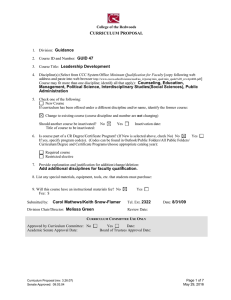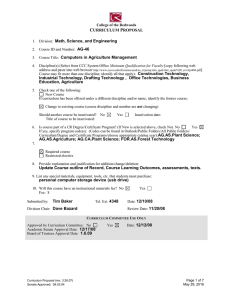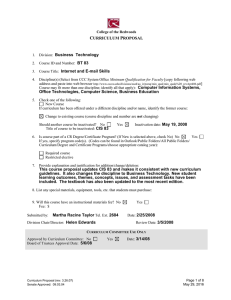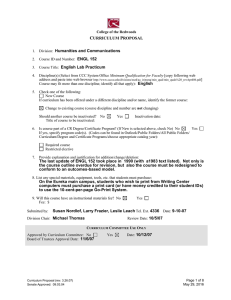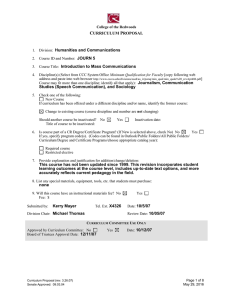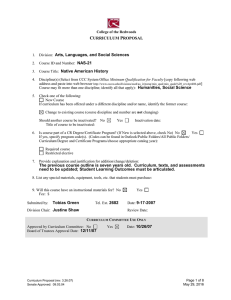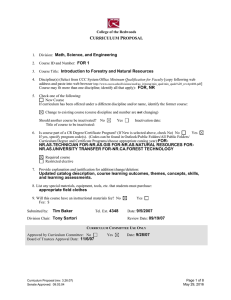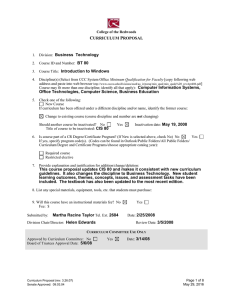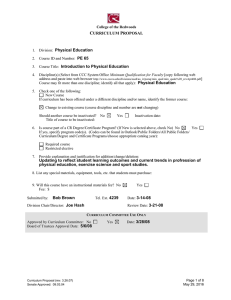C P
advertisement
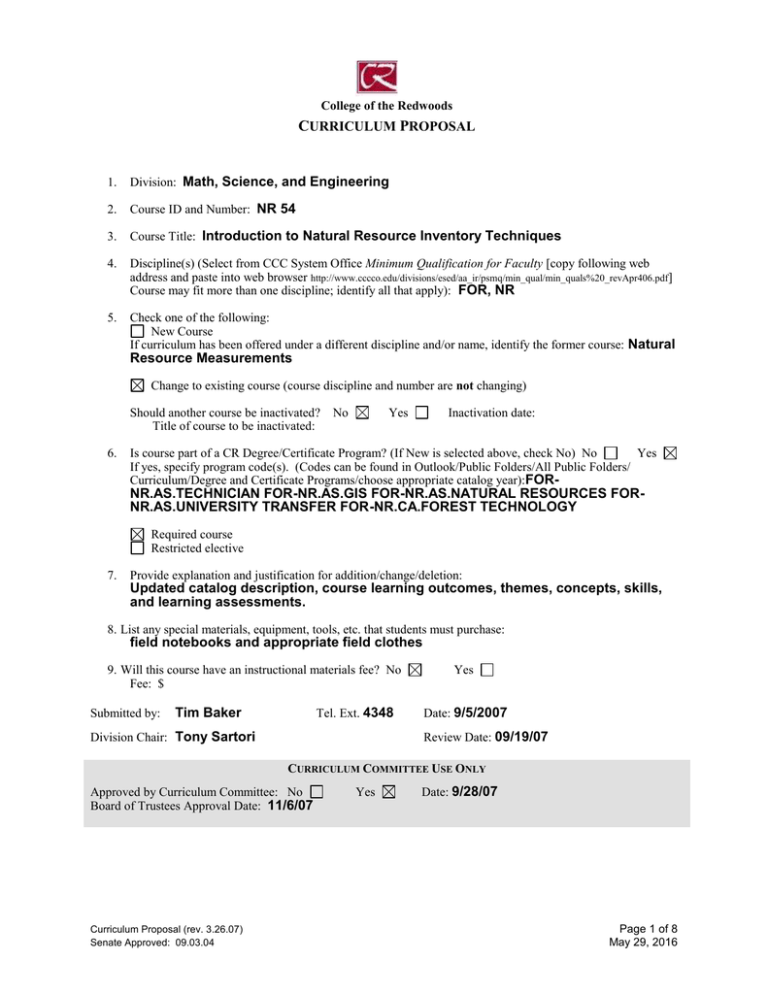
College of the Redwoods CURRICULUM PROPOSAL 1. Division: Math, Science, and Engineering 2. Course ID and Number: NR 54 3. Course Title: Introduction to Natural Resource Inventory Techniques 4. Discipline(s) (Select from CCC System Office Minimum Qualification for Faculty [copy following web address and paste into web browser http://www.cccco.edu/divisions/esed/aa_ir/psmq/min_qual/min_quals%20_revApr406.pdf] Course may fit more than one discipline; identify all that apply): FOR, NR 5. Check one of the following: New Course If curriculum has been offered under a different discipline and/or name, identify the former course: Natural Resource Measurements Change to existing course (course discipline and number are not changing) Should another course be inactivated? Title of course to be inactivated: 6. No Yes Inactivation date: Is course part of a CR Degree/Certificate Program? (If New is selected above, check No) No Yes If yes, specify program code(s). (Codes can be found in Outlook/Public Folders/All Public Folders/ Curriculum/Degree and Certificate Programs/choose appropriate catalog year):FOR- NR.AS.TECHNICIAN FOR-NR.AS.GIS FOR-NR.AS.NATURAL RESOURCES FORNR.AS.UNIVERSITY TRANSFER FOR-NR.CA.FOREST TECHNOLOGY Required course Restricted elective 7. Provide explanation and justification for addition/change/deletion: Updated catalog description, course learning outcomes, themes, concepts, skills, and learning assessments. 8. List any special materials, equipment, tools, etc. that students must purchase: field notebooks and appropriate field clothes 9. Will this course have an instructional materials fee? No Fee: $ Submitted by: Tim Baker Tel. Ext. 4348 Division Chair: Tony Sartori Yes Date: 9/5/2007 Review Date: 09/19/07 CURRICULUM COMMITTEE USE ONLY Approved by Curriculum Committee: No Board of Trustees Approval Date: 11/6/07 Curriculum Proposal (rev. 3.26.07) Senate Approved: 09.03.04 Yes Date: 9/28/07 Page 1 of 8 May 29, 2016 SUMMARY OF CURRICULUM CHANGES FOR AN EXISTING COURSE FEATURES Catalog Description (Please include complete text of old and new catalog descriptions.) Grading Standard OLD NEW The study of the concepts and practices involved in measuring natural resources for inventory and management purposes. Map reading will be covered, along with measureing distances and directions on the ground and on maps and aerial photographs. Students will learn basic sampling techniques and procedures used in wildlife, watershed and recreation situations. Equipment used will include cloth and steel tapes, diameter tapes, Abney levels, clinometers, Biltmoresticks, hand and staff compasses, increment boreres, relaskops, densiometers, GPS recievers, electronic data collectors, and more. Data analysis will be done by hand and on computers. An introduction to various techniques used in the measurement and inventory of natural resources. Topics include map reading and drawing, land navigation, tree measurement, sampling methods and data analysis. Students will work with a variety of biometric devices in field settings to gain practical experience in their application and use. Select Select FOR 1, IT 161 or Math 105/106 FOR 1, MATH 15 Total Units Lecture Units Lab Units Prerequisites Corequisites Recommended Preparation Maximum Class Size 24 Repeatability— Maximum Enrollments Course title, Course learning outcomes, course content, learning assessments If any of the listed features have been modified in the new proposal, indicate the “old” (current) information and proposed changes. Other Curriculum Proposal (rev. 3.26.07) Senate Approved: 09.03.04 Page 2 of 8 May 29, 2016 College of the Redwoods COURSE OUTLINE DATE: 9/5/2007 COURSE ID AND NUMBER: NR 54 COURSE TITLE: Introduction to Natural Resource Inventory Techniques FIRST TERM NEW OR REVISED COURSE MAY BE OFFERED: Spring 2008 TOTAL UNITS: 3 TOTAL HOURS: 90 [Lecture Units: 2 [Lecture Hours: 36 Lab Units: 1] Lab Hours: 54] MAXIMUM CLASS SIZE: 24 GRADING STANDARD Letter Grade Only CR/NC Only Is this course repeatable for additional credit units: No Grade-CR/NC Option Yes If yes, how many total enrollments? Is this course to be offered as part of the Honors Program? No Yes If yes, explain how honors sections of the course are different from standard sections. CATALOG DESCRIPTION The catalog description should clearly state the scope of the course, its level, and what kinds of student goals the course is designed to fulfill. An introduction to various techniques used in the measurement and inventory of natural resources. Topics include map reading and drawing, land navigation, tree measurement, sampling methods and data analysis. Students will work with a variety of biometric devices in field settings to gain practical experience in their application and use. Special notes or advisories: Field trips are required; the College does not provide transportation. PREREQUISITES No Yes Course(s): Rationale for Prerequisite: Describe representative skills without which the student would be highly unlikely to succeed . COREQUISITES No Yes Rationale for Corequisite: Course(s): RECOMMENDED PREPARATION No Yes Course(s): FOR 1, MATH 15 Rationale for Recommended Preparation: Curriculum Proposal (rev. 3.26.07) Senate Approved: 09.03.04 Page 3 of 8 May 29, 2016 A background in statistics and an introduction to forest and natural resources will enhance both the amount of material covered during the semester and the sophistication of data analyses possible by the student. COURSE LEARNING OUTCOMES What should the student be able to do as a result of taking this course? State some of the objectives in terms of specific, measurable student accomplishments. 1. 2. 3. 4. Develop and use functional maps and navigate to specific points on the ground. Plan and conduct field inventories and analyze data into useful reports. Explain sampling design, statistical analysis and measurement practices. Derive solutions to inventory problems. COURSE CONTENT Themes: What themes, if any, are threaded throughout the learning experiences in this course? The practical application of statistical theory. Concepts: What concepts do students need to understand to demonstrate course outcomes? 1. Statistical sampling 2. Variation in natural resource populations. 3. Mathematical principles of measurement techniques (e.g. relationship of circumference to diameter, angle of view and height, volume of truncated paraboloids). 4. Relationship between spatial location and sample size. 5. Application of theory. Issues: What primary issues or problems, if any, must students understand to achieve course outcomes (including such issues as gender, diversity, multi-culturalism, and class)? Skills: What skills must students master to demonstrate course outcomes? 1. Map reading and development of sketch maps. 2. Land navigation, including compass and pacing and GPS techniques. 3. Tree measurement using d-tapes, clinometers and Biltmore sticks. 4. Use of measurement tools including lasers, Relaskop, and densiometers. 5. Basic statistical analysis including means, variance and confidence intervals. REPRESENTATIVE LEARNING ACTIVITIES What will students be doing (e.g., listening to lectures, participating in discussions and/or group activities, attending a field trip)? Relate the activities directly to the Course Learning Outcomes. 1. Reading, lectures and discussions on the techniques used to read and develop maps, locate and describe positions, measure trees and other resources, sampling theory and inventory planning. 2. Conduct various field exercises that demonstrate the use of various tools and techniques and analyze data gathered in these exercises. Curriculum Proposal (rev. 3.26.07) Senate Approved: 09.03.04 Page 4 of 8 May 29, 2016 ASSESSMENT TASKS How will students show evidence of achieving the Course Learning Outcomes? Indicate which assessments (if any) are required for all sections. Representative assessment tasks: 1. Solve problems on tree measurement and forest sampling on problem sets and quizzes. 2. Design inventories for specific scenarios on quizzes and lab projects. 3. Define and use technical language on quizzes. 4. Complete a group project that maps, plans, conducts and analyzes an inventory of a forest. Required assessments for all sections – to include but not limited to: Group project conducting an inventory of a forest stand. EXAMPLES OF APPROPRIATE TEXTS OR OTHER READINGS Author, Title, and Date Fields are required Author Avery and Burkhart Author Bongarten et al. Title Title Author Title Date Author Title Date Forest Measurements Forest Measurements Date Date 1999 2003 Other Appropriate Readings: Wilson, 1988 Elementary Forest Surveying and Mapping. Dilworth and Bell 1988 Handbook of Cruising and Log Scaling Curriculum Proposal (rev. 3.26.07) Senate Approved: 09.03.04 Page 5 of 8 May 29, 2016 PROPOSED TRANSFERABILITY: CSU UC If CSU transferability is proposed (courses numbered 1-99), indicate whether general elective credit or specific course equivalent credit is proposed. If specific course equivalent credit is proposed, give course numbers/ titles of at least two comparable lower division courses from a UC, CSU, or equivalent institution. None General elective credit Specific course equivalent 1. FOR 210, Humboldt State University (Campus) 2. FNR 215, Cal Poly- San Luis Obispo (Campus) CURRENTLY APPROVED GENERAL EDUCATION CR CSU IGETC CR GE Category: CSU GE Category: IGETC Category: PROPOSED CR GENERAL EDUCATION Rationale for CR General Education approval (including category designation): Natural Science Social Science Humanities Language and Rationality Writing Oral Communications Analytical Thinking PROPOSED CSU GENERAL EDUCATION BREADTH (CSU GE) A. Communications and Critical Thinking A1 – Oral Communication A2 – Written Communication A3 – Critical Thinking C. Arts, Literature, Philosophy, and Foreign Language C1 – Arts (Art, Dance, Music, Theater) C2 – Humanities (Literature, Philosophy, Foreign Language) E. Lifelong Understanding and SelfDevelopment E1 – Lifelong Understanding E2 – Self-Development B. Science and Math B1 – Physical Science B2 – Life Science B3 – Laboratory Activity B4 – Mathematics/Quantitative Reasoning D. Social, Political, and Economic Institutions D0 – Sociology and Criminology D1 – Anthropology and Archeology D2 – Economics D3 – Ethnic Studies D5 – Geography D6 – History D7 – Interdisciplinary Social or Behavioral Science D8 – Political Science, Government and Legal Institutions D9 – Psychology Rationale for inclusion in this General Education category: Same as above Curriculum Proposal (rev. 3.26.07) Senate Approved: 09.03.04 Page 6 of 8 May 29, 2016 Proposed Intersegmental General Education Transfer Curriculum (IGETC) 1A – English Composition 1B – Critical Thinking-English Composition 1C – Oral Communication (CSU requirement only) 2A – Math 3A – Arts 3B – Humanities 4A – Anthropology and Archaeology 4B – Economics 4E – Geography 4F – History 4G – Interdisciplinary, Social & Behavioral Sciences 4H – Political Science, Government & Legal Institutions 4I – Psychology 4J – Sociology & Criminology 5A – Physical Science 5B – Biological Science 6A – Languages Other Than English Rationale for inclusion in this General Education category: Curriculum Proposal (rev. 3.26.07) Senate Approved: 09.03.04 Same as above Page 7 of 8 May 29, 2016 FOR VPAA USE ONLY PROGRAM AND COURSE NUMBER NR-54 TECHNICAL INFORMATION 1. Department: SCI Science 16. CoRequisite Course: None 2. Subject: Nat Res 17. Recommended Prep: None Course No: 54 3. Credit Type: D Credit Degree Applicable 18. Maximum Class Size: 24 4. Min/Maximum Units: 3.0 to 19. Repeat/Retake: NR No repeats variable units 5. Course Level: C Clearly Occupational 20. Count Retakes for Credit: yes no 6. Academic Level: UG Undergraduate 21. Only Pass/No Pass: yes no 7. Grade Scheme: UG Undergraduate 22. Allow Pass/No Pass: yes no 8. Short Title: Intro/Nat'l Res Invntry Tchnqs 23. VATEA Funded Course: yes no 9. Long Title: Intro to Natural Resources 24. Accounting Method: W Weekly Census Inventory 25. Disability Status: N Not a Special Class 10. National ID (CIP): 03.0101 26. Billing Method: T-Term 11. Local ID (TOPS): 011500 27. Billing Period: R-Reporting Term 12. Course Types: Level One Basic Skills: NBS Not Basic Skills Level Two Work Experience: 28. Billing Credits: 3.0 29. Purpose: I Occupational Ed NWE Not Coop Work Experience 30. Articulation No. Level Three: (CAN): Placeholder for GE OR 31. Articulation Seq. (CAN): DOES NOT APPLY 32. Transfer Status: B Transfers to CSU only Level Four: If GE : Choose One: 33. Equates to another course? FOR-54 (course number). 13. Instructional Method: LL Lecture/Lab 14. Lec TLUs: 3.0 Contact Hours: 36 Lab TLUs: 3.0 Contact Hours: 54 Lecture/Lab TLUs: 6.0 Contact Hours: 90 34. The addition of this course will inactive number). Inactive at end of term. 15. Prerequisite: None Particular Comments for Printed Catalog. . Curriculum Approval Date: 9/28/07 Curriculum Proposal (rev. 3.26.07) Senate Approved: 09.03.04 Page 8 of 8 May 29, 2016 (course
